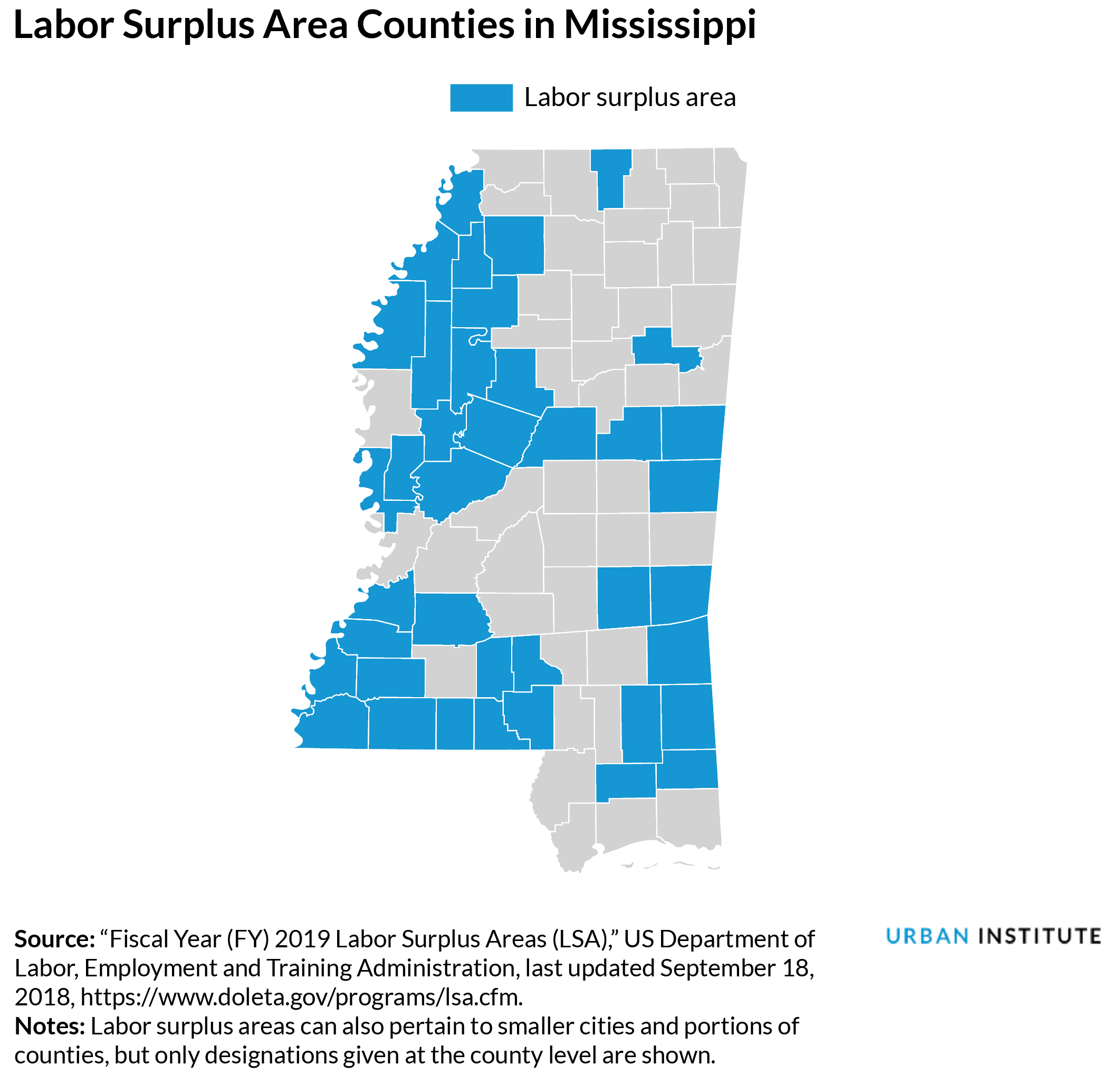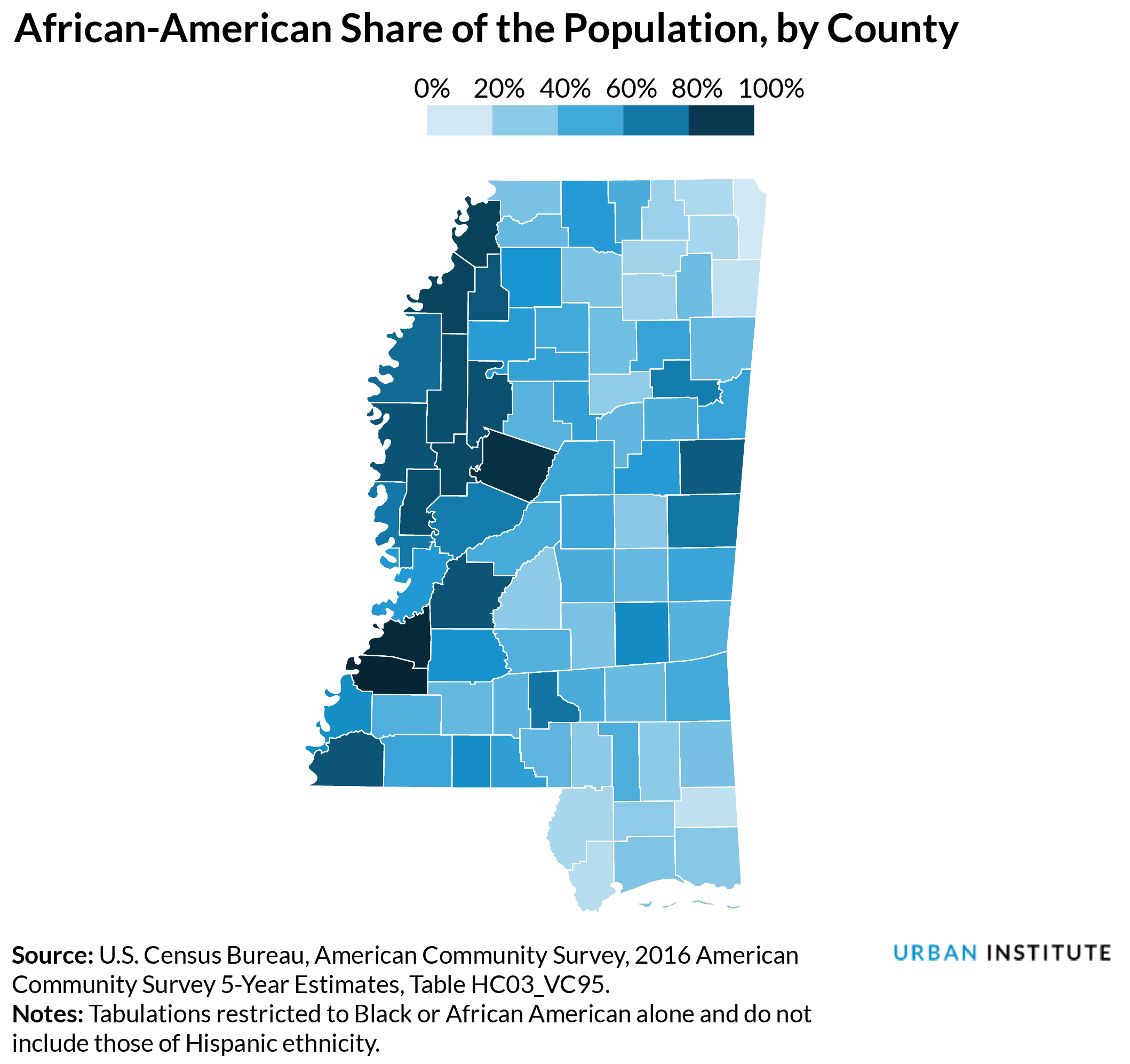
<p>George, who is homeless, stands in a street on January 3, 2016 in Biloxi, Mississippi. According to the US Census Bureau, Mississippi is the nation's poorest state with a median income of $39,680. Photo by Spencer Platt/Getty Images.</p>
The policy discussion around work requirements in public safety net programs typically assumes that jobs or training opportunities that lead to stable employment are readily available and that all we need are rules to ensure that people receiving benefits are not avoiding work.
But a closer look at on-the-ground economic conditions in Mississippi indicates that employment opportunities are not available in all counties. In fact, the lack of opportunity is notable in counties with large African American populations.
Mississippi is 1 of 11 states seeking federal approval to implement work requirements for certain Medicaid enrollees. In its application—known as a Medicaid waiver because it proposes a change to existing program rules—Mississippi requests permission to require certain enrollees to work, volunteer, or participate in approved training for 20 hours a week. Among those exempt are pregnant women, caregivers of disabled family members or children younger than 6, and people diagnosed with a mental illness.
In 2016, Mississippi also reinstated a three-month time limit and work requirements for adults ages 18 to 49 without dependents who receive Supplemental Nutrition Assistance Program (SNAP) benefits. These time limits can be waived if an area’s unemployment rate exceeds 10 percent or lacks available jobs, but Mississippi does not exempt any counties.
Although Mississippi’s economy has improved since the Great Recession, it still lags behind the nation as a whole. In June 2018, Mississippi’s statewide, non–seasonally adjusted unemployment rate was 5.7 percent, compared with a national unemployment rate of 4.2 percent. In 2016, the statewide African American employment rate was 11.9 percent, more than double that of whites (5.2 percent).
Although the difference between white and black unemployment isn’t unique to Mississippi, more often than not, economically depressed counties in Mississippi are also majority-black counties, raising concerns that African Americans may be at greater risk of losing Medicaid coverage if the federal government approves the state’s waiver and may have already been disparately affected by the reinstatement of SNAP time limits.
In four maps, we illustrate geographic and racial disparities in economic opportunity across Mississippi to inform considerations of work requirements in safety net programs.
1. Many counties have higher unemployment rates than the statewide average
If Mississippians need to look for work or find a job with more hours, their prospects will depend heavily on where they live. In June 2018, unemployment rates across counties varied from 4 to 14.9 percent.
Twenty-five of the state’s 82 counties, or 30.5 percent, had unemployment rates exceeding 7 percent, while Claiborne, Holmes, and Jefferson Counties had unemployment rates higher than 10 percent, the average national unemployment rate during the Great Recession.

2. Nearly half of Mississippi’s counties are labor surplus areas, where there are more job seekers than jobs
While the monthly unemployment rate provides a snapshot in time, labor surplus areas flag wider geographic areas where the average annual unemployment rate is 20 percent or higher than the average annual unemployment rate for all 50 states during the prior two years.
Understanding the persistence of higher-than-average unemployment rates in the same location over time offers additional clues about the resilience of local labor markets. Counties designated as labor surplus areas consistently lack enough available jobs for people seeking work.
As of December 2017, when the latest data are available, 39 of Mississippi’s 82 counties, or 48 percent, were designated as labor surplus areas.

3. Nearly 60 percent of counties suffer from persistent poverty
Persistent poverty counties are areas where 20 percent or more of the population has lived in poverty over the past 30 years according to census data. Persistent poverty counties suffer from long-term economic disadvantage that will likely require sustained attention and investment.
Forty-eight of Mississippi’s 82 counties, nearly 60 percent, have persistent poverty, are concentrated in the western part of the state.

4. African American residents tend to live in counties where there is high unemployment, persistent poverty, and more jobs seekers than jobs.
The disparity in employment opportunities is pronounced in counties that are majority African American. Of the counties with unemployment rates higher than the June 2018 statewide average, 43 percent are majority African American. Fifty-nine percent of labor surplus counties and 50 percent of persistent poverty counties are majority African American.

Given that Medicaid and SNAP can be important work supports, a more thorough assessment of employment opportunities within Mississippi and how they differ by geography and race is essential for ensuring that work requirements in safety net programs do not exacerbate economic challenges, compound historical disadvantages of African American communities, or undermine resident health and well-being.
Mississippi and other states will need to tackle overlapping racial and geographic disparities to avoid benefit losses among enrollees with greater barriers to employment and position them for high-quality jobs that provide private health insurance coverage and decent wages for food and other basic necessities.
Let’s build a future where everyone, everywhere has the opportunity and power to thrive
Urban is more determined than ever to partner with changemakers to unlock opportunities that give people across the country a fair shot at reaching their fullest potential. Invest in Urban to power this type of work.